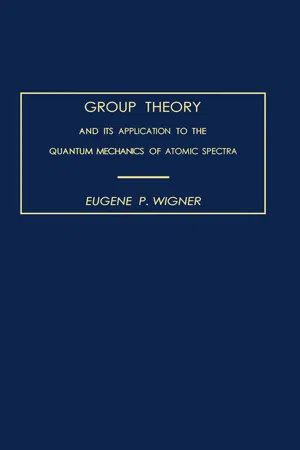
- 386 pages
- English
- PDF
- Available on iOS & Android
About This Book
Group Theory: And Its Application To The Quantum Mechanics Of Atomic Spectra aims to describe the application of group theoretical methods to problems of quantum mechanics with specific reference to atomic spectra. Chapters 1 to 3 discuss the elements of linear vector theory, while Chapters 4 to 6 deal more specifically with the rudiments of quantum mechanics itself. Chapters 7 to 16 discuss the abstract group theory, invariant subgroups, and the general theory of representations. These chapters are mathematical, although much of the material covered should be familiar from an elementary course in quantum theory. Chapters 17 to 23 are specifically concerned with atomic spectra, as is Chapter 25. The remaining chapters discuss topics such as the recoupling (Racah) coefficients, the time inversion operation, and the classical interpretations of the coefficients. The text is recommended for physicists and mathematicians who are interested in the application of group theory to quantum mechanics. Those who are only interested in mathematics can choose to focus on the parts more devoted to that particular area of the subject.
Frequently asked questions
Information
Table of contents
- Front Cover
- Group Theory: And its Application to the Quantum Mechanics of Atomic Spectra
- Copyright
- Table of Contents
- Author's Preface
- Translator's Preface
- Chapter 1. Vectors and Matrices
- Chapter 2. Generalizations
- Chapter 3. The Principal Axis Transformation
- Chapter 4. The Elements of Quantum Mechanics
- Chapter 5. Perturbation Theory
- Chapter 5. Perturbation Theory
- Chapter 6. Transformation Theory and the Bases for the Statistical Interpretation of Quantum Mechanics . .
- Chapter 7. Abstract Group Theory
- Chapter 8. Invariant Subgroups
- Chapter 9. The General Theory of Representations
- Chapter 10. Continuous Groups
- Chapter 11. Representations and Eigenfunctions
- Chapter 12. The Algebra of Representation Theory
- Chapter 13. The Symmetric Group
- Chapter 14. The Rotation Groups
- Chapter 15. The Three-Dimensional Pure Rotation Group
- Chapter 16. The Representations of the Direct Product
- Chapter 17. The Characteristics of Atomic Spectra
- Chapter 18. Selection Rules and the Splitting of Spectral Lines
- Chapter 19. Partial Determination of Eigenfunctions from Their Transformation Properties
- Chapter 20. Electron Spin
- Chapter 21. The Total Angular Momentum Quantum Number
- Chapter 22. The Fine Structure of Spectral Lines
- Chapter 23. Selection and Intensity Rules with Spin
- Chapter 24. Racah Coefficients
- Chapter 25. The Building-Up Principle
- Chapter 26. Time Inversion
- Chapter 27. Physical Interpretation and Classical Limits of Representation Coefficients, Three- and Six-j Symbols
- Appendix A. Conventions
- Appendix B. Summary of Formulas
- Subject Index